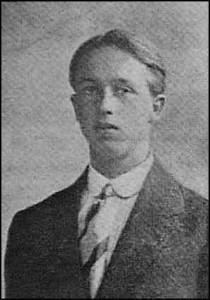Category: Military
Rank: Private 622
Regiment or Ship: 3rd Brigade 10th Australian Light Horse
Service Number(s): 622
Occupation: Farm Hand
Date of Birth: 02.07.1894
Place of Birth: Darlington, Durham, England
Date of Death: 25.07.1915 (on board a hospital ship)
Place of Death: Gaba Tepe, Gallipoli
Place of Burial / Memorials:
Buried at Sea – Commemorated on Lone Pine Memorial, in Turkey. on Panel 10.
Address: Lancing College (1911 census) Albany, Western Australia (Australian Imperial Force Nominal Roll)., Lancing, West Sussex
Photos and newspaper articles
Family Information
Parents:-
Charles Luxmoore Hockin (1852 – 1900) and Catherine Mary Brabant (1858 – 1935)
Siblings:
Christine Catherine Luxmoore Hockin (1885 – 1937) born Birmingham, Warwickshire
Muriel Luxmoore Hockin (1886 – 1960) born Darlington
Phyllis Luxmoore Hockin (1888 – 1958) born Darlington
Percy Frederick Netherton Luxmoore Hockin (1889 – 1974) born Darlington on 8th September 1889, died 24th Febuary 1974 in Welwyn Garden City, Hertfordshire, England
Gwendolene Luxmoore Hockin (1891 – 1891) born Darlington, on 22nd Nov 1892
Eileen Steuart Hockin – born1892 in Darlington
Charles Owen Luxmoore Hockin born 27th June 1897 in Hornchurch, Essex, died 13th July 1977 in Worcester Park, Surrey.
Stuart was never married and died at the age of 21.
Note. “Stuart” has been spelled “Stewart” and “Steuart”, in various documents.
First World War Experience
Stuart Roy Luxmore Hockin came to Bexhill in 1903, where he lived until he emigrated to Bunbury, in Australia in September 1913 where he worked as a farm hand.
On the outbreak of the First World War he enlisted in the 3rd. Brigade, Australian Light Horse at Claremont Camp, Perth in Western Australia on the 23rd October 1914. On his enlistment it was recorded that he was 20 years and 3 months old, 5 feet ten inches tall with blue eyes and fair hair. He was posted for training as reinforcement.
On the 17th of February 1915, he embarked at Freemantle for Egypt on board the HMAT “Surada”. After a short period in Egypt he, again, embarked at Alexandria to join the Mediterranean Expeditionary Force on the 16th of May 1915, heading for Gallipoli.
On May 19th, he was among the Australians who, under Sir Ian Hamilton, performed what was considered to be impossible by landing on an open beach, strewn with land and sea mines, barbed wire that stretched down even into deep water, with machine-guns arranged so that every yard of sand and water could be swept, by direct, indirect, and cross fire, with a hose-like stream of bullets.
On 23rd July 1915, he became ill with dysentery and was taken on board the hospital ship “Somali”, which was anchored off Gaba Tepe. His condition however, worsened and two days later he died of dysentery. Due to the conditions on land, he was buried at sea.
He was posthumously awarded the normal three medals (commonly known as “Pip, Squeak, and Wilfred”) – the 1914-15 Star, the British War Medal, and the Victory Medal.
Additional Information
Stuart, and each of his siblings, was given the additional name “Luxmoore” as part of their first name. It doesn’t appear that it was intended to form part of a hyphenated surname. It is often spelled “Luxmore” but the original spelling was Luxmoore, with two ‘oo’s and it was the surname of Stuart’s great great grandmother – Rebecca Cunningham Luxmoore (1751 – 1833) and goes right back to Thomas Luxmoore of Morestone, in Devon (1530 – 1606), which is around the beginning of parish registers, and other records become difficult to find.
Stuart went to Lancing College near Shoreham, Sussex, England, where he served for 3 years in the Officer’s Training Corps, and it was here that he was found in the 1911 census.
On his service records his next of kin was given as being his mother, Mrs C Luxmore Hockin, 7 Elmstead Road, Bexhill, Sussex, England. He enlisted in the Australian 10th Light Horse Regiment on 23rd October 1914 at Guildford, Western Australia
His father was a lawyer in England. One older brother and one younger joined up at the beginning of the war, in England, and served on the Western Front till the end of the war. Both were in the London Regiment and both survived the war.
“Pte HOCKIN, Stewart Roy Luxmoore, 10th L H.R.” – this is the wording by which he is remembered on the West Australian State Memorial, according to the Australian newspaper “Western Mail”, Published in Perth, dated “Thursday 21st August 1930” (Page 13 of 52).
Stuart’s Probate Record runs as follows “4 Warrior-square, St Leonards-on-Sea, private, 10th Australian Light Horse Regiment, died 25 July 1915 at sea. Administration London 14 October to Catherine Blocks more Hockin, widow, Effects £284 4s.”


